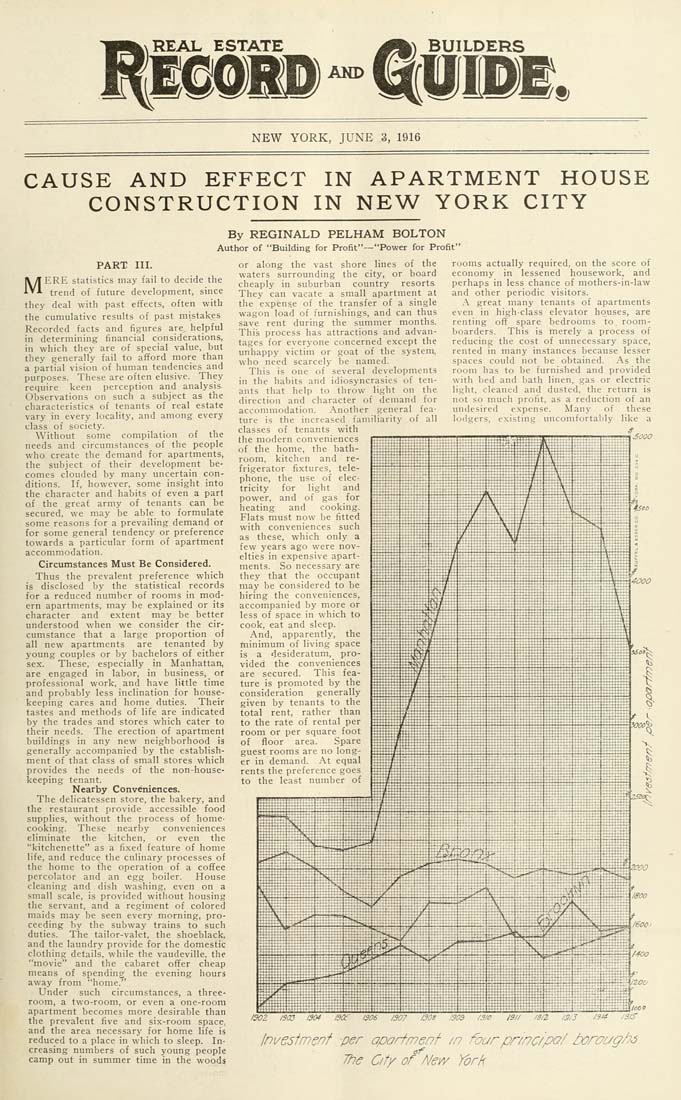Columbia University Libraries Digital Collections: The Real Estate Record
Use your browser's Print function to print these pages.
Real estate record and builders' guide: [v. 97, no. 2516: Articles]: June 3, 1916

Text version:
Please note: this text may be incomplete. For more information about this OCR, view About OCR text.
REAL ESTATE AND NEW YORK, JUNE 3, 1916 CAUSE AND EFFECT IN APARTMENT HOUSE CONSTRUCTION IN NEW YORK CITY By REGINALD PELHAM BOLTON Author of "Building for Profit"—"Power for Profit" PART III. MERE statistics may fail to decide the trend of future development, since they deal with past effects, often with the cumulative results of past mistakes Recorded facts and figures are helpful in determining financial considerations, in which they are of special value, but they generally fall to afford more than a partial vision of human tendencies and purposes. These are often elusive. They require keen perception and analysis. Observations on such a subject as the characteristics of tenants of real estate vary in every locality, and among every class of society. Without some compilation of the needs and circumstances of the people who create the demand for apartments, the subject of their development be¬ comes clouded by many uncertain con¬ ditions. If, however, some Insight into the character and habits of even a part of the great army of tenants can be secured, we may be able to formulate some reasons for a prevailing demand or for some general tendency or preference towards a particular form of apartment accommodation. Circumstances Must Be Considered. Thus the prevalent preference which is disclosed by the statistical records for a reduced number of rooms in mod¬ ern apartments, may be explained or its character and extent may be better understood when we consider the cir¬ cumstance that a large proportion of all new apartments are tenanted by young couples or by bachelors of either sex. These, especially in Manhattan, are engaged In labor, in business, of professional work, and have little time and probably less inclination for house¬ keeping cares and home duties. Their tastes and methods of life are indicated by the trades and stores which cater to their needs. The erection of apartment buildings in any new neighborhood is generally accompanied by the establish¬ ment of that class of small stores which provides the needs of the non-house¬ keeping tenant. Nearby Conveniences. The delicatessen store, the bakery, and the restaurant provide accessible food supplies, without the process of home- cooking. These nearby conveniences eliminate the kitchen, or even the "kitchenette" as a fixed feature of home life, and reduce the culinary processes of the home to the operation of a coffee percolator and an egg boiler. House cleaning and dish washing, even on a small scale, is provided without housing the servant, and a regiment of colored maids may be seen every morning, pro¬ ceeding by the subway trains to such duties. The tailor-valet, the shoeblack, and tlie laundry provide for the domestic clothing details, while the vaudeville, the "movie" and the cabaret offer cheap means of spending the evening hours away from "home." Under such circumstances, a three- room, a two-room, or even a one-room apartment becomes more desirable than the prevalent five and six-room space, and the area necessary for home life is reduced to a place in which to sleep. In¬ creasing numbers of such young people camp out in summer time in the woods or along the vast shore lines of the waters surrounding the city, or board cheaply in suburban country resorts. They can vacate a small apartment at the expense of the transfer of a single wagon load of furnishings, and can thus save rent during the summer months. This process has attractions and advan¬ tages for everyone concerned except the unhappy victim or goat of the system, who need scarcely be named. This is one of several developments in the halilts and idiosyncrasies of ten¬ ants that help to throw light on the direction and character of demand for accommodation, .\nother general fea¬ ture Is the Increased familiarity of all classes of tenants with the modern conveniences of the home, the batli- rooni, kitclien and re¬ frigerator fi.xtures, tele¬ phone, the use of elec¬ tricity for light and power, and of gas for heating and cooking. Flats must now be fitted with conveniences such as these, which only a few years ago were nov¬ elties in expensive apart¬ ments. So necessary are they that the occupant may be considered to be hiring the conveniences, accompanied by more or less of space in which to cook, eat and sleep. And, apparently, the minimum of living space is a desideratum, pro¬ vided the conveniences are secured. This fea¬ ture is promoted by the consideration generally given by tenants to the total rent, rather than to the rate of rental per room or per square foot of floor area. Spare guest rooms are no long¬ er in demand, .-^t equal rents the preference goes to the least number of rooms actually required, on the score of economy in lessened housework, and perhaps in less chance of mothers-in-law and other periodic visitors. .\ great many tenants of apartments even in high-class elevator houses, are renting off spare bedrooms to. room- boarders. This Is merely a process of reducing the cost of unnecessary space, rented In many instances because lesser spaces could not be obtained. As the room lias to be furnished and provided with bed and liath linen, gas or electric light, cleaned and dusted, the return is not so much profit, as a reduction of an undeslred expense. Many of these lodgers, e.xisting uncomfortably like a if HSaoo I30Z 1303 ;3i^ ,-"-;■ -"-"-- .i.r /SOS .'303 /S/o /9.. :■ Z S.J /.9f* .S.'S Investment 'per apartment /n fourpnnc/pG/ lproug/?<5 The Qty or Ate// tor/f